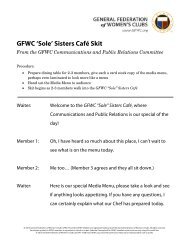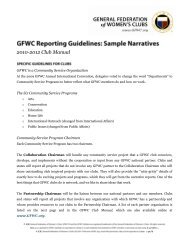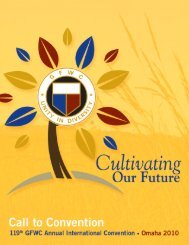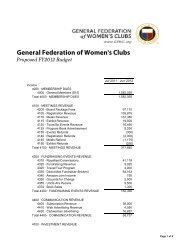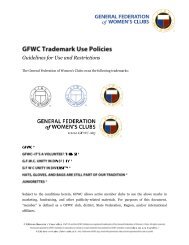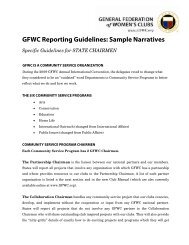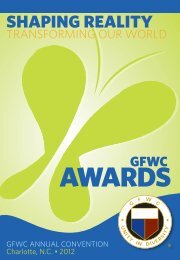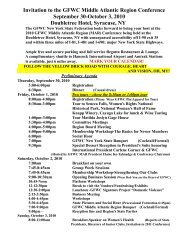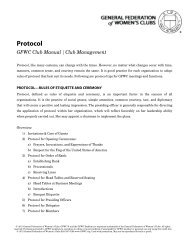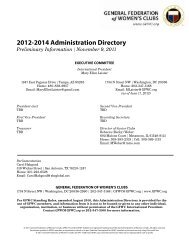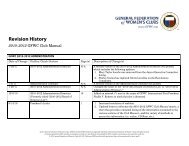Annual Report - General Federation of Women's Clubs
Annual Report - General Federation of Women's Clubs
Annual Report - General Federation of Women's Clubs
You also want an ePaper? Increase the reach of your titles
YUMPU automatically turns print PDFs into web optimized ePapers that Google loves.
Conservation Community Service ProgramYear in ReviewThe GFWC Conservation Community Service Program promotes advocacy, education, and action to encouragethe understanding <strong>of</strong> and appreciation for all aspects <strong>of</strong> our environment and conservation <strong>of</strong> the world’sresources, natural and manmade. Below are several examples <strong>of</strong> conservation projects led by GFWC clubs.GFWC Abington Heights Civic League, Inc.(Pennsylvania) had a vision to create a space where people cancome together to learn how to garden organically; watch theirlabor blossom and grow; provide a healthy economic source <strong>of</strong>nutrition; and enjoy the beauty <strong>of</strong> the community. Its goal was toestablish a community garden to grow produce. Club memberssecured partners and raised funds. The community libraryheld seminars presented by Penn State Master Gardeners, whoeducated attendees on organic gardening without the use <strong>of</strong>pesticides and herbicides, practicing water conservation, startingseeds, and making compost. News <strong>of</strong>the project spread fast via the localnewspaper and television stations.The library’s children’s group planteda butterfly and pollination garden. Achurch group maintained a plot anddonated the harvested produce to localfood banks. Others joined the effort and over 2,000 pounds <strong>of</strong>fresh produce reached more than 200 qualified area families.Conservation by the NumbersDollars Donated $2,422,483Hours Volunteered 466,883Projects Completed 12,213GFWC Nome (Alaska) maintains the garden at Potter Station,which is considered a wonderful photo opportunity for touristsas it is a stop for tour buses.GFWC Walhalla (South Carolina) dubbed their downtowncleanup “Company’s Comin’”. Just before the town’s annualOktoberfest week, club members swept main street sidewalks,picked up litter and debris, and trimmed shrubbery. Theyredesigned the landscaping and in the spring, added plants andflowers to the town’s welcome signs, where they also wateredand maintained them—now it’s timefor company.GFWC Peterson Tuesday Club(Iowa) floated on a section <strong>of</strong> a riverto pick up trash. The participantsreported back to the club on the itemsand quantity <strong>of</strong> trash retrieved to educate and make others aware<strong>of</strong> the extent <strong>of</strong> the river trash.GFWC Livermore Falls Women’s Club (Maine) workedwith the local Betterment Group to transform a vacant dirty lotinto a vibrant color spot that made townspeople take notice andstart sprucing up their own areas. The club also made a gardendesigned to attract eyes to museum signs at their local Paper& Heritage Museum. The members learned their living historymuseum had suffered a devastating fire and had a garden thatneeded attention. The club members sprang into action, alongwith middle school students, who called looking for a projectin which they could participate. The students received printedinstructions to help them remember what they learned from theactivity as well as day lilies to plant at their own homes. From thisclub’s First Impressions Project the community benefitted andthe club gained recognition and community acknowledgment.GFWC Chamber’s Bay (Washington) adopts an apple treeevery year at a local orchard that is maintained by the city andwhere concerts and other community events are held. Memberslearn to prune the tree by attending classes, and use the applesfor some wonderful desserts. Any leftover apples are used at acommunity event called “The Apple Squeeze.”GFWC Pennsylvania worked with its state agencies to educateits members on invasive plant species as the President’s Projectwas “Dangerous Invasions,” and the first step was to educatemembers about the plant species invading our environment andthe effects on our ecosystem.GFWC Boulder Valley (Colorado) adopted a section <strong>of</strong>Coal Creek Trail in Louisville, learned about the invasive plants,cleaned brush, cut down weeds, and dug up and bagged nonnativenoxious weeds growing in that area. A sign with the club’sname was placed on the trail.GFWC Amity Study Club <strong>of</strong> Atlanta (Texas) collected over10,000 pounds <strong>of</strong> e-waste (old computers, printers, televisions,mobile phones, and PDAs) in one day. The club used its localnewspaper, radio station, and fliers to get the word out anddrafted their family members’ help with the collecting. UNICOR<strong>of</strong> Texarkana, a recycling plant that works in conjunction withthe Department <strong>of</strong> Justice, which allows prisoners in federalinstallations to receive pay and to learn vocational skills throughrecycling <strong>of</strong> disposed electronics, came with its truck, and aforklift was donated to help with the loading.2009-2010 GFWC ANNUAL REPORT 5



